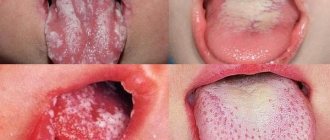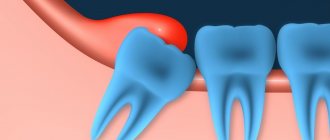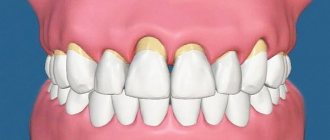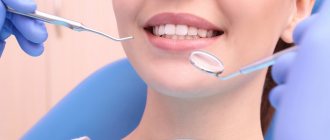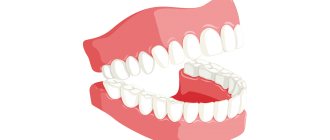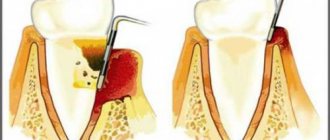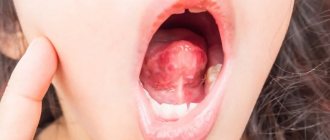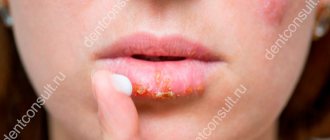Periodontal diseases (literally translated as “diseases of what surrounds the teeth” - that is, diseases of the gums and bone tissue that support the teeth) are infectious diseases that are the main cause of tooth loss in adults. According to international statistics, more than 60% of the total adult population of industrialized countries suffers from periodontitis.
Traditional methods of treating periodontitis
Today, dentists can offer many medicinal methods for treating periodontitis. However, some still prefer to deal with this problem with the help of “grandmother’s recipes.” Is it worth starting treatment for periodontitis with folk remedies or is it still necessary to go to the doctor?
Periodontitis is an unpleasant disease from any point of view. It causes not only bleeding and painful sensitivity of the gums, loosening and displacement of teeth, but also bad breath, and also makes a person’s appearance rather unattractive. If treatment is not started in time, the acute local process will become chronic, and may even lead to tooth loss.
How to fight periodontitis
A dentist’s help with periodontitis involves making a correct diagnosis and prescribing adequate treatment, depending on the severity of the disease and the individual characteristics of the patient’s body. After carrying out the necessary medical procedures in a dental clinic, treatment of periodontitis should be continued at home. For this purpose, special solutions, medicinal herbs and various folk remedies are used.
Folk remedies
Improving and treating gums with periodontitis using folk remedies is possible only after professional sanitation of the oral cavity. If plaque and tartar are not removed, the gum mucosa will be constantly injured, and pathogens will cause inflammatory processes. Let's say you did everything right: you visited a doctor, performed professional hygienic cleaning, took a course of medication (if it was prescribed). Here's what else might help:
- Beekeeping products Honey and propolis have always been used for stomatitis - their safety and effectiveness make it possible to recommend them even to small children. And if you add viburnum or chokeberry to healing honey, you can get an excellent remedy for periodontitis. The mixture is prepared from one type of ground berries and honey in a 4:1 ratio, and is used as a dessert after meals. You can alternate viburnum and chokeberry daily. The duration of taking this tasty “medicine” is 25–30 days.
- Medicinal herbs For rinsing, a decoction of comfrey or an infusion of oak bark with linden flowers are useful. Crushed comfrey roots should be simmered over low heat for 20 minutes, then cooled and used for daily rinsing twice a day. An infusion of oak bark is prepared in the same way, but after boiling, linden flowers are added to it and allowed to brew. The ratio of oak bark and linden blossom should be 2:1. You should rinse your mouth with this infusion 4-5 times a day until the symptoms disappear completely.
- Vegetable oils A mixture can be prepared from sea buckthorn and fir oil to lubricate the gums. the procedure using it is carried out twice a day, carefully rubbing the mixture into the gums using gauze, which is wrapped around a finger. To achieve the desired effect (that is, relieve inflammation), you need to carefully, with smooth circular movements, massage the gums in this way both from the outside and from the inside.
Modern means
To treat periodontitis at home, modern pharmacological agents are also used - ready-made medicinal rinses and special toothpastes. The solutions have anti-inflammatory, disinfecting, antimicrobial and analgesic effects. Many of them contain not only chemicals, but also extracts of medicinal herbs, some contain antibiotics. Therefore, when choosing a medicinal solution or toothpaste, consult your dentist to ensure that the product is not only effective, but also safe.
Expert opinion
The use of folk remedies in the treatment of periodontitis at the initial stage is quite effective - provided, of course, that the disease is not in an acute phase and does not require urgent dental intervention, for example, to remove tartar that causes inflammation. “Medicines from the people” cope well with the problem of bacterial plaque during the prevention of various inflammatory diseases. And for chronic periodontitis, treatment with folk remedies is the most effective “weapon” from the entire arsenal of preventive measures that can prevent relapses of the disease. However, it is recommended to use folk remedies only under the supervision of a doctor, since they often cause serious allergic reactions that complicate the course of the disease. Therefore, before you undertake periodontitis treatment on your own, visit a dentist who will give you all the necessary recommendations taking into account the characteristics of your body.
Alternative medicine
Typically, the best-known treatments are those that use ingredients that are readily available to everyone.
Salt
Ingredients: Salt (table or sea) and water.
Preparation: for 225 ml of water at room temperature, 1 tsp. salt.
Application: Soak a toothbrush in the composition and treat the oral cavity. The solution is also suitable for rinsing.
Efficiency: bacteria are destroyed, inflammation is relieved, bleeding is reduced, gums are strengthened.
The course of treatment is 7 days.
Hydroperite
Ingredients: 100 gr. 3% hydroperite solution and two cloves of garlic.
Chop the vegetables and mix with the solution.
Soak a piece of cotton wool in the solution and rub the periodontal tissues.
Result: the gums become elastic and stop bleeding.
The duration of the course is at least two weeks.
Rules for choosing electric toothbrushes for children, and at what age you can start using the device. Come here if you are interested in Amazing White whitening reviews.
At this address https://dr-zubov.ru/lechenie/zuby/bruksizm/skrezhet-vo-sne-prichina-chto-delat.html you will find out whether teeth grinding in a dream really occurs from worms.
Native American toothpaste
Ingredients: 3 tablespoons (tablespoons) of ground sea salt, 1 teaspoon (teaspoon) of spruce resin, 3 pinches of burnt banana peel ash, olive oil.
Mix the ingredients until a medium thick paste is formed.
Treatment of gums. Keep the resulting saliva in your mouth for 10 minutes, and after spitting, do not rinse your mouth at the end of the procedure. Try not to skip the procedure in the mornings and evenings.
What it gives: Indian paste enriches the periodontal area with vitamins and microelements. Application period: 3 months.
Soda + salt + birch ash
Ingredients: a spoonful of salt (teaspoon), soda - 2 spoons (teaspoons), birch ash - 3 spoons (tablespoons).
Burn the top white layer of birch bark over a fire and sift the resulting ashes through a sieve. Mix all ingredients. Store the mixture in a jar with a tightly closed lid for no more than a year.
It is advisable to brush your teeth every other day for 3 months.
Tartar disappears, tooth loosening stops, gums become stronger, and their bleeding stops.
Aloe
Cut a fragment of aloe leaf into 2 parts, remove all thorns.
Application: Apply to sore gums while you sleep.
Results: not only does inflammation of the periodontal tissues go away and microbes are destroyed, but the entire body is healed.
Relief occurs on the third day. The procedures must be continued for 10 days.
Sap
Composition: 1 part cedar resin, 5 parts alcohol.
Pour the resin with alcohol until it dissolves.
Massage the infected areas with a homogeneous liquid in the morning and evening.
What happens: the oral cavity is cleansed of harmful bacteria, the roots of the teeth and soft tissues of the mucous membrane are strengthened.
You need to repeat the procedure for 3 months.
Lingonberry juice
Required: fresh lingonberry.
Preparation: soak a cotton swab with the drink.
How to use: periodically apply to the gums several times a day.
Efficiency: even the most advanced stage of periodontal disease recedes. After three days of treatment, swelling subsides and the gums become tightly adjacent to the teeth.
Course: 2 months.
Pomegranate peel
Required: 250 ml of water, peel of one pomegranate.
Boil the pomegranate peel in water for 4 minutes, leave.
Application: pour into tea or other drinks.
Result: the decoction enriches the body with vitamins and serves as a good preventative medicine for periodontal disease.
It takes 1 month. Repeat the course every spring.
Bergenia root
Ingredients: 30 sachets of thick-leaved saxifrage root. Brew and insist.
Rinse your mouth with tea.
Consequences: inflammation is relieved.
Duration of use is 1 month.
Forms and dangers of herpetic stomatitis in children, methods of its treatment. Click here if you want to know what medications you can take for toothache during pregnancy.
Follow the link https://dr-zubov.ru/krasota-i-uxod/sredstva/opolaskivateli/glister-amvej-effektivnoe-sredstvo.html to get to know the Glister mouthwash, its advantages and disadvantages.
pine needles
Take 30 pine needles. Rinse them and dry them.
Twice a day you should carefully chew the needles until the taste is completely lost.
Results: the oral cavity is disinfected and gum bleeding stops.
Treatment time: 3 weeks.
Beet
Take 1 root vegetable of any variety. The vegetable is finely grated raw.
After dinner, apply beetroot pulp to your gums and cover your mouth with a bandage. You should lie with your mouth closed and this bandage for at least half an hour. There is no need to rinse your mouth at the end of the session.
Inflammation in the oral cavity disappears and the gums are restored.
It is necessary to repeat the procedure for 3 - 4 months.
Kalanchoe
Take a Kalanchoe leaf. A small fragment of it should be washed and cleaned.
Lightly press onto the areas around the teeth and leave for 10-20 minutes.
Efficacy: having a bactericidal and astringent effect, the plant quickly copes with the symptoms of periodontal disease.
The procedures need to be carried out for 2 weeks.
Garlic + black tea
Ingredients: 1 large spoon of chopped garlic, 1 glass of hot black tea.
Garlic should be poured into tea, leave the mixture for half an hour and strain.
Rinse your mouth with the infusion for 10 minutes. Do the procedure twice a day.
The product strengthens teeth and significantly helps in the treatment of periodontal disease.
The duration of treatment is at least two months.
Garlic + oil
Ingredients: 250 g of finely chopped garlic, 150 g of vegetable oil and 6 drops of eucalyptus essential oil.
First, you need to mix the base oil and vegetable together, transfer the mixture into a glass container, seal it and place it in the sun for a week and a half. It is necessary to periodically approach and shake the bottle. After this, strain the mixture, add the essential substance, pour it all into a dark vessel and refrigerate.
Application: compresses for gums. They should be done 3 times a day.
The antibacterial mixture effectively relieves the symptoms of periodontal disease.
Course of therapy: 30 days.
Kefir fungus
Ingredients: a couple of small spoons of milk fungus, a glass of warm milk.
Pour milk over the mushroom and set it aside to sour for exactly one day. Afterwards, strain, add milk again and let it ferment again. The output is kefir.
Drink in the morning on an empty stomach and shortly before bed. During kefir treatment, spicy and fatty foods and alcohol should be excluded from the diet.
The product slowly, surely and systematically destroys periodontal disease.
Required: 20 days of drinking the drink, take a break for a month. Next – 3 weeks of admission.
Apple cider vinegar
You will need: vinegar (1 tsp), 100 ml of water. Dilute vinegar with water.
It is advisable to rinse your mouth with this solution three times a day. You need to fill your mouth with half a sip of vinegar, clench your jaws and use the muscles of your tongue and lips to direct the liquid into the interdental spaces. It is necessary to ensure that the vinegar flows between the gaps of the teeth in powerful jets. The procedure should take about 3 minutes.
What it does: eliminates bleeding gums, helps fill the spaces between teeth with soft tissue and whitens the enamel.
The course of treatment is 1 month.
What contributes to the development of periodontal disease?
Factors contributing to the development of the disease:
- vascular disease and a tendency to form plaques;
- hormonal disorders;
- weakened immunity;
- side effects of medications;
- smoking;
- lack of vitamins;
- structural features of the gums and jaw.
Symptoms to watch out for:
- Unexplained pale gums
- Redness
- Visible lengthening of the tooth due to the opening of the neck
- Increased sensitivity to hot and cold
- Periodic bleeding.
- Unexplained itching in the gums
- Loosening of teeth that begins with slight mobility.
Any of the above symptoms is a reason to consult a dentist. He will make a diagnosis and develop a treatment plan for periodontal disease. Whether it will be carried out entirely at home or with mandatory visits and medical procedures depends on the actual stage of the disease.
Clinical picture of the disease
Periodontitis is characterized by pronounced symptoms. If they appear, you should immediately consult a dentist. Characteristic features include:
- bad breath;
- the occurrence of pathological periodontal pockets;
- bleeding gums during brushing;
- increased tooth sensitivity to hot and cold foods;
- presence of a metallic taste in the mouth.
Treatment of gums at home
How to treat inflammation? There are many ways to treat gum inflammation at home. Dentists usually recommend antiseptic drugs with anti-inflammatory effects. The optimal treatment regimen is prescribed by the dentist after diagnosis. Let's consider the most effective treatment options.
Rinse with solutions
Rinsing with special solutions helps to quickly get rid of pain and stop inflammatory processes occurring in soft tissues. The compositions of the solutions disinfect the surface of the gums, destroying pathogenic bacteria. It is necessary to rinse your gums after every meal, 2 to 4 times a day. Some drugs in this group are used in pure form, others must be diluted in water.
To treat inflamed gums, dentists usually prescribe the following solutions:
- Furacilin;
- Chlorhexidine;
- Miramistin;
- Rotokan;
- Stomatophyte;
- Malavit;
- Listerine;
- Chlorophyllipt.
The listed drugs are usually used to prevent diseases of the oral cavity, reduce pain and reduce inflammation, but do not apply to independent means of treatment. Therefore, rinsing is usually prescribed in combination with other procedures.
Bee products
Invaluable beekeeping products - honey and propolis - help in the difficult task of saving from insidious periodontal disease.
- Ingredient: 5% propolis ointment . Application: treat affected areas of periodontal tissue. There is a clearing of the gum sockets, and a little later - restoration of the mucous membrane. Thanks to the latter effect, the impact of the microbial environment on the necks of the teeth is reduced, and pain is blocked. Requires 1 month of daily massage.
- Ingredients: crushed propolis (25 g), 100 ml of alcohol, 50 g of dry St. John's wort leaves, vegetable oil.
Fill a dark glass bottle with propolis. Pour alcohol into it. Stir the contents of the bottle thoroughly and add St. John's wort leaves. Leave the solution for 15 days. Lubricate inflamed areas 3 times a day with a mixture of 2 tablespoons of vegetable oil and 1 tablespoon of the resulting tincture. What happens: periodontal tissue is restored, microbes are destroyed. The course of treatment is 2 months. - Ingredients: salt (5 g), honey (20 g). Mix the ingredients together to form a scrub. Place the mixture in gauze and rub it into the gums in a circular motion. Result: the periodontium is saturated with vitamins, blood circulation improves. The course of treatment is 5 weeks.
- Ingredients: 1 tbsp. spoon of honey, 1 tbsp. spoon of cinnamon mix well .
Apply at night to the affected areas of the mucous membrane. In the morning, rinse your mouth with warm water. Carry out the procedure daily. What it does: heals, disinfects the oral cavity. For recovery: 1 week of use. - Propolis is taken in its pure form and a thin strip is formed . Apply the plate to the gums at night. This method should be used very carefully, as there is a risk of propolis getting into the respiratory tract. As a result: pathogenic microbes are destroyed, the mucous membrane is restored. Duration of use is 1 month.
The video presents several more recipes to get rid of the symptoms of the disease.
Differences between periodontal disease and periodontitis
Patients often confuse the names, and therefore turn to dentists, complaining of periodontal disease. In 90-93% of cases, ordinary periodontitis is detected. It is widespread. Our disease is rare.
Periodontitis manifests itself through:
- pain on palpation, when brushing teeth;
- bleeding;
- redness of the gum margin;
- swelling;
- cyanosis.
In severely advanced cases, there may also be headaches, fever and severe toothache. All this leads to refusal of food and hygienic cleaning of the oral cavity.
By place of development:
- localized - a small lesion affecting only one tooth; often results from mechanical damage to tissue;
- generalized - damage to several teeth also affecting the gingival and bone tissue.
According to the nature of the course:
- acute - characterized by sudden pain attacks and rapid development of symptoms;
- chronic periodontitis is the transition of untreated acute periodontitis to a chronic form, in which pain and other symptoms practically disappear, but the disease progresses and deforms the tissue.
Teeth in danger: how to recognize the disease
Thanks to advertising, even children know about caries. But periodontal diseases are still a closely guarded mystery. Let's eliminate this gap. Periodontitis is an inflammatory disease that affects the tissue around the tooth and gums. As a result, loose teeth and other unpleasant “bonuses” appear.
Periodontitis - symptoms:
- gums bleed, especially under stress (chewing hard food, brushing);
- sensations of itching and pulsation under the gums;
- bad breath even after hygiene procedures;
- the mucous membrane around the teeth changes color;
- dark hard deposits on the enamel;
- periodontal pockets and tooth mobility appear.
Signs of the chronic form:
- inflammation and swelling of the gums;
- the mucous membrane becomes bright red;
- discharge of pus from periodontal pockets;
- throbbing severe pain;
- weakness, general malaise, possible fever.
We continue to understand the features of the disease: to understand whether you belong to the “risk group”, you need to know where gum inflammation comes from.
Periodontitis - causes:
Insufficient oral hygiene is the most common reason. Residues of food, falling under the gums, provoke the formation of microbes and the development of inflammation.
Food poor in vitamins and microelements.
- The predominance of soft food on the menu. The gums do not receive the necessary “massage” and there is insufficient blood flow.
- Complications of gingivitis and stomatitis.
- Weakened immunity, chronic diseases (diabetes mellitus).
- Very tight fit of teeth to each other (crowding).
- Allergies to medications and chemicals.
It’s simply amazing when some patients want to get rid of an illness that takes years to develop in a few days. People ask how to treat periodontitis with folk remedies and sincerely believe that this is a panacea. We responsibly declare that “grandmother’s spells”, miraculous rinses and ointments will at most ease the pain, but will not stop the development of the disease.
Professional dentistry involves complex treatment of periodontitis - more complex and lengthy, but effective.
- Consultation with a periodontist is the first step. The doctor will make an accurate diagnosis and determine a further treatment plan. After the x-ray diagnosis, the specialist will be able to answer the questions: is it possible to save the teeth or will some have to be parted with;
- will tell you how to treat periodontitis , how much the procedure will cost;
- coordinates treatment and prosthetic options;
- will determine the sequence of methods in the clinic.
Massage
Many doctors recommend supplementing the treatment of periodontal disease with massage, which improves blood circulation and accelerates metabolic processes in the affected tissues. People used some means to get a greater effect from massage.
Cranberry
Required: cranberries.
Wash the berries and crush them in your hands.
Massage the periodontal areas after each meal.
Efficiency: saturates the affected periodontal tissues with useful microelements and restores them.
20 days is the period for regular treatment.
Hydrogen peroxide
Required: 30 drops of peroxide, half a glass of water.
Prepare the solution.
Using your fingers soaked in this liquid, massage your gums for 3 minutes in the morning and evening.
Result: weakened gums become elastic again and teeth become strong.
Massage course: 1.5 months.
Thin oak branches
You will need oak or pine branches. Rinse and break them to suitable sizes.
You need to chew the twigs thoroughly until they turn into tattered tassels. There are also special exercises:
- For the first week, bite the twig from top to bottom with gradual pressure.
- For the second - holding a branch in the front teeth with moving the jaws to the right and left.
- For the third - attempts to tear off a piece of a branch by stretching it in the teeth.
Result of application: periodontal muscles are strengthened. More blood flows to the periodontal tissues, which helps the gums heal.
Duration of therapeutic massage is 3 months.
Sea buckthorn oil
Sea buckthorn oil is required. You need to warm it up slightly under running hot water.
The index finger is dipped in sea buckthorn oil and the gums are massaged for 3 minutes. This massage should be done twice a day. If blood comes out during a massage, you should not be afraid of it.
Benefit: tissues are mineralized and the symptoms of periodontal disease disappear.
Daily massage course – 2 weeks. A total of 5 courses per year are required.
Salt + oil
Ingredients: ground sea salt (1 tbsp), olive oil (1 tbsp). Mix the substances until a paste is obtained.
Gently apply the product to the mucous membrane and rub it into the upper and lower gums with gentle movements.
Result: blood circulation in the periodontal tissues improves, and they are saturated with iodine.
Time required: 5 weeks.
Sauerkraut
Used: sauerkraut.
Using gauze, squeeze out a little juice from the product and place it in a cup.
Massage the periodontium with this juice.
Efficacy: noticeable reduction in symptoms within a week.
The duration of the sessions is 2 weeks.
For more information about treating the disease using folk remedies and massage, watch the video.

